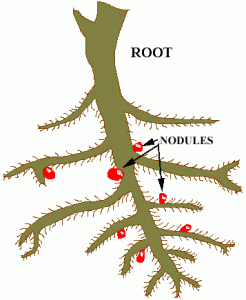Organic Solutions: Rhizobia, Yeoman’s Plow, Carbon Sequestering, and Earthworms
 Question from Mary:
Question from Mary:
I read the link you sent on coffee grounds. It’s not the paper I originally read, but delivers the essentials. The fact that coffee grounds are not acidic was news to me, too. We just created a compost pile yesterday using them, so we shall see for ourselves.
We listened to another youtube lecture by Darren Doherty last night–he’s the Australian that I mentioned in regard to carbon sequestering and the special plow, which is called a yeomans plow, after the agriculture and water engineer who invented it, and who had many theories and practices that were later adopted by permaculturists in Australia, especially regarding water capture and conservation. Here’s a pretty good synopsis of his ideas and the plow: http://agwaterstewards.org/txp/Resource-Center-Articles/21/keyline-design and here is yeomans’s web site: www.yeomansplow.com.au
In the youtube (if you google yeomans plow, several Doherty youtubes come up), Doherty confirmed our assumptions that the increase in carbon sequestering actually comes from ground-cover roots being able to grow longer and deeper as a result of the special plowing, which brings moisture, air, and beneficial bacterias and fungi deeper into the soil, and also breaks up compacted soil BENEATH the surface. As you will glean from the article, the plow has special properties that prevent up-turning/over-turning the soil–which is the main problem with conventional plows. Of course, you would plow when the land is dry to prevent (further) compaction. When I first heard about this, I said, well, you can just sow sweet clover, whose roots grow 2.5 feet deep and break up any hard-pan in the process to achieve the same effect, as far as the carbon sequestering goes–the water retention improvement may be further improved by the yeomans plow; also, depending upon how you plow, you can direct the water, which you cannot do by simply planting sweet clover.
Regarding the no-till approach, I love the concept–and just loved the book One Straw Revolution, which was the first I believe to promote it. HOWEVER. We have gophers, so we have no choice but to dig, in order to line the growing areas with gopher wire. We dig as much as 4x4x4 holes for trees. All row crops are grown on gopher-wire-lined raised beds that are first dug between 18 and 24 inches deep, etc. Even so, they killed a greengage plum tree this past summer. We have lots of snake and owl habitat that is working (many owl pellets with gopher bones), and I am beginning to get selective about the ground covers I use (gophers love the daikon radishes in my brassica mix, I found), and limit their range, because they can attract and feed gophers. Gophers are about the only creatures that eat velvet grass, one of the worst exotic-invasives in our area–so getting rid of that will also help. They also love Queen Anne’s Lace, which is hugely invasive (bees love it too, but we can compensate there). We are not into trapping and killing.
We have been inoculating the roots of everything we have planted with mycorrhizal fungi since Day One, over six years ago. I am glad that you concur with the benefits. Do you have a favorite product (there are so many now–when we started, there was one, and it was and is very expensive)?
A trip to the Mendocino Botanical Gardens ignited a passion in us for heathers and grevilleas. I recently got a wonderful book on heathers (so beautiful, and a great favorite of bees–and evidently heather honey is quite a delicacy. Why I bring this up is because these acid-loving, poor-soil plants (Ericaceae–including bluberries and cranberries, which we also grow)) require completely different fungi. I haven’t delved into that yet, but this book says that giving the wrong incoculants can adversely affect the plants…
I read about the devastating results that worms have on forest duff and forests in a New York Times article that I was using for sheet mulch (I have read many great articles in the process of sheet-mulching!) This was an eye-opener and very good to know! I have done a lot of reforesting of the riparian zones and ridges that surround our growing areas, and have used compost and mulches in the process, but did not add worms from the bins, as I do in the cultivated areas. Still, evidently significant damage is done by worms that escape from people who are fishing in forest streams…
Answer from Pat:
Thanks for sending so much helpful information on intriguing organic subjects and solutions. I also have visited the Mendocino Botanic Gardens years ago and marveled at the health of the azaleas growing in the acid soil, just right for them under pine trees. Regarding the expense of inoculants, I think it’s just a matter of time when lower-cost products will be available. Meanwhile hunting around often brings results. Peaceful Valley Farm and Garden Supply often is less expensive than some. Gardens Alive may be feeling the pinch of tight economic times and has more frequent sales than formerly.

